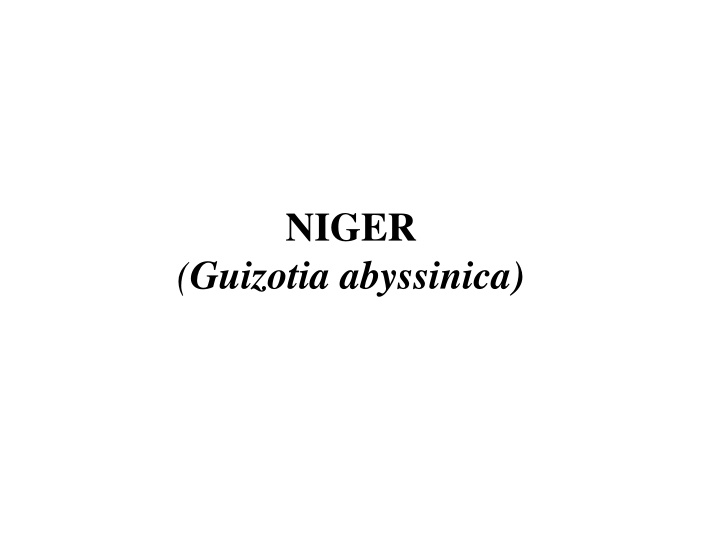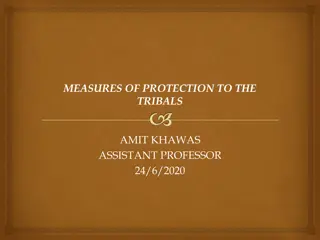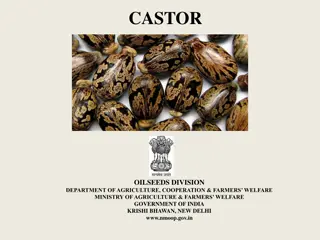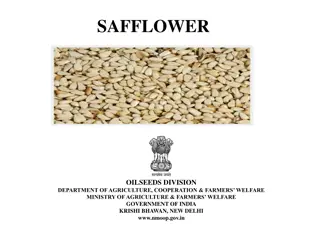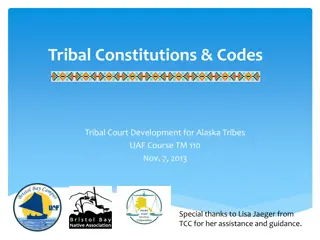Niger: A Versatile Oilseed Crop with Tribal Significance in India
Niger, a minor oilseed crop with origins in Ethiopia, is crucial for tribal economies in India. It produces edible oil rich in unsaturated fatty acids. The plant belongs to the Compositae family and requires specific climate and soil conditions for optimal growth. With a moderate temperature range and adequate rainfall, Niger thrives in select regions of India, contributing significantly to the local economy.
Download Presentation

Please find below an Image/Link to download the presentation.
The content on the website is provided AS IS for your information and personal use only. It may not be sold, licensed, or shared on other websites without obtaining consent from the author.If you encounter any issues during the download, it is possible that the publisher has removed the file from their server.
You are allowed to download the files provided on this website for personal or commercial use, subject to the condition that they are used lawfully. All files are the property of their respective owners.
The content on the website is provided AS IS for your information and personal use only. It may not be sold, licensed, or shared on other websites without obtaining consent from the author.
E N D
Presentation Transcript
NIGER (Guizotia abyssinica)
Niger, although a minor oil seed crop in the world and national economy of India, is of considerable imporatance to tribal economy in many niger growing areas states of India. Niger (Guizotia abyssinica) has its center of gene variations and origin in the Ethioafrican islands north of 400 N latitude. From Ethiopua it is believed to have migrated to the east African islands like millions of years ago it might give moved across to India with crops finger millet. Niger seed contains 35-40% edible oil. The oil contains 85% unsaturated and 15% saturated fatty acids. Linoleic and oleic acids are the major unsaturated ones. Raw niger oil is readily subject to oxidative rancidity reducing its keeping quality. The niger oil used for and in paints and soft soaps, lubricants and for cosmetics. It is mainly used for edible purposes. Niger seed cake is used as a valuable cattle feed and manures. Niger seed is also exported to several western countries as a bird feed.
Guizotia belongs to compositae family the tribe Helianthoides. Its of 6 abyssinica species is the cultivated one with, 2n= 30. It is an annual, lightly branched 35-200 cm tall, with a well developed root system. Two to three buds are formed close together at the top of the branches followed by the formation of buds in the axils of leaves. A single plant often produses 20 to 40 heads. The ray florets are female and normally produce seeds. Each floret consists of tribe of fire lobes units a distinct upper section surrounding the style and stamens and a lower section surrounding the ovary. It takes 40-45 days from flowering to maturity. T he fruit is an acheme, small about 35 mm in length and 1.5 mm in width. There are usually 15-30 mature seeds/head. Niger is basically cross pollinated, although some self pollinated is known to occur. Insects are more important than wind as pollinators.
Distribution: Niger crop is mainly grown in Ethiopia and provides about 50-60% for that country's edible oil. In India, it is grown in 4.36 lakh hectares with total production of 1.11 lakh tones and a productivity of 235 kg/ha. It accounts for less than 0.5% of toal oilseed production in India. Orissa, MP, MH and Jharkhand are the major niger producing states.
Climate and soil: Niger is temperate crop but is also adapted to sub tropical countries. It grows from 200 to 2500 mm above mean sea level. Niger requires moderate temperature of 18-230 C during growth and at above 300C, the rate of growth and flowering are adversely affected and it hastens maturity. Seed bed temperature of 17-250 c is optimum for germination. Temperature below 100 C lowers germination and above 350 C emergence. Rainfall of 1000- 1300 mm is considered as optimum although 800 mm will produce a reasonable yield, if it is well spread over growing period. The peak flowering period should not coincide with rainy period as honey bees which are main pollinators of this crop get disturbed resulting in poor seed setting. The crop can withstand very high soil moisture during vegetative phase and is also resistant to drought.
Niger can be grown in a wide range of soil types but it thrives best in clay loams and sandy clays. It is grown extremely as marginal and submarginal lands in tribal areas . The crop prefers light textured soils and heavy black cotton soils are not suitable for niger. The optimum pH range is 5.2 to 7.3. The crop is extra ordinarily resistant to poor oxygen supply in soils because of its ability to develop aerenchymatous tissue under these conditions.
Cropping systems: Niger is grown either as a sole crop or sown as a mixed crop with various pulses and gram crops including millets in different states of India. However, the yield of niger as a sole crop is higher than as a mixed crop. Sequential cropping: Bihar: Maharastra: Orissa : Little millet-niger, finger millet-niger. Finger millet, Horse gram- niger. Niger+ Soybean/pearl millet(2:2), Niger + finger millet/Groundnut (6:3), Niger + castor (6:1).
Land preparation: Niger seeds are small, therefore levelled seed bed is required to ensure of preper sowing and subsequent emergence. Land preparation as that for small grains is suitable for niger also. Good tilth for sowing is obtained by one or two ploughings followed by two harrowings. It is necessary to plough across slope to avoid soil erosion in hill top and slopy areas.
Varieties: A large number of high yielding varieties have been developed in India. Bihar/Jharkhand- GA-10, GA-5, Birsa niger, P. niger Karnataka- No-71, IGP 76, GA 10, GA 5 MP- Ootacer, IGP 76, GA 10, NO. 71, JNC-1, JNC-6, JNS-9 MH- IGP-76, JNC-6, JNS-9 Orissa- IGP-76, NO. 71, GA-5, GA-10. Time of sowing: Optimum sowing time for Kharif crop is from middle June to early August and rabi crop can be sown in September.
Seed rate and spacing: The seed rate depends on method of sowing. Generally 5-8 kg/ha is required when sown in rows. Spacing varies from 20-30 cm depending on soil moisture and amount of fertilizer applied. In low rainfall areas, row spacing should be followed. It is often thinned after emergence to 15-20 cm between plants.
Method of sowing: The most common method of sowing by farmer in India is broadcasting. Seed is mixed with soil to assist uniform distribution. The land is then harrowed to cover seed. Line sowing using seed drill is recommended. When mechanized planter is used, the seed should be sown 1-3 cm deep depending on the soil type and amount of seed bed moisture and up to 10 cm is in loose soils in which drilled furrow should not be mixed with fertilizers, and seeds are not placed in contact seed bed. Seed must be sown in to moist soil and level of available soil moisture should be adequate to sustain germination and emergence varies with soil type. A higher level is necessary in sandy soil than clay. Radicle elongation after germination of niger seed is faster in clay than in sandy soil. Niger germinates very quickly under optimum condition and can be above ground in 3-5 days.
Nutrient management: Niger is mostly grown on marginal and submarginal lands without manures and fertilizers. It appears that niger can be benefited from species specific of Rhizobium inoculation to promote N fixation and uptake through root nodulation. It was suggested that mycorrhiza which grows on the root is inoculated to mobilise P uptake. This explains that why niger grows well on relatively infertile soils. The manures and fertilizers are generally broadcasted in the field. Generally entire quantity of P and half of N is applied at the time of sowing and the remainimg half of N is top dressed at 30-35 days later when plants are 30 cm height. Bihar: 20: 20: 0 All P and half N at sowing and another half at 30 DAS Karnataka: 20: 20: 10 at sowing MP: 20: 20: 0 same as bihar MH: 20: 0: 0 at sowing Orissa: 40: 40: 0 same as Bihar
Weed management: Niger grows rapidly once the seedlings are established and its growth allows it to compete with annual weeds, provided pre-planting operations have removed the majority of weeds. Two weedings are generally sufficient. First weeding is done at the time of thinning at 15 DAS. Second one is before top dressing of N. In Orissa, dodder (Cuscuta chinensis) is a parasitic weed. Parasites germinate along with the crop and is known to reduce yields by 60-65%. Early infestation and later infestation at 30/45 DAS causes total losses. Use of weed free seeds (if mixed sieving should be done before sowing). Chemicals are against dodder. Chloroprophan granules @ 4 kg/ha, Propyzamide @ 1.5- 2.0 kg/ha at 20-25 DAS, Pronomide at 2.0 kg ai/ha pre-emergent as well as post emergent at 20 DAS.
Water management: Niger is mostly grown in rainy season and seedling stage is more critical for moisture . It is tolerant to water logging. Yields can be doubled under irrigation to be scheduled based on soil and climatic condition.
Harvesting and threshing: Niger normally matures in about 80-145 days after emergence. Correct timing for harvesting of niger is an is reducing shattering. Shattering can reduce up to 25%. The crop should be harvested when dry up and head turns blackish. After drying in sun for about a week staking on threshing floor, the crop is threshed by beating with sticks. Yield potential: Yield varies with the method of cultivation of niger. As a pure crop, 400-500 kg/ha could be obtained. Yields up to 1000 kg/ha have been recorded in demonstration plots. When intercropped, yield may range from 150-300 kg/ha depending on the crop and row ratio
Storage of seed: Niger seeds attract storage pests and must be protected from them. After threshing, winnowing is done to clean weeds. The seeds are dried in minimum for 2-3 days to bring down the moisture to 5%. Then they are stored in gunny bags in home with good ventilation and moisture inside the storage. For small time seed storage 200 litre oil treated with preservatives proved most effective.
